
Chalkidiki, also known as Chalcidice, is a peninsula and regional unit of Greece, part of the region of Central Macedonia, in the geographic region of Macedonia in Northern Greece. The autonomous Mount Athos region constitutes the easternmost part of the peninsula, but not of the regional unit.

Missolonghi or Mesolongi is a municipality of 32,048 people in western Greece. The town is the capital of Aetolia-Acarnania regional unit, and the seat of the municipality of Iera Polis Mesolongiou. Missolonghi is known as the site of a dramatic siege during the Greek War of Independence, and of the death of poet Lord Byron.
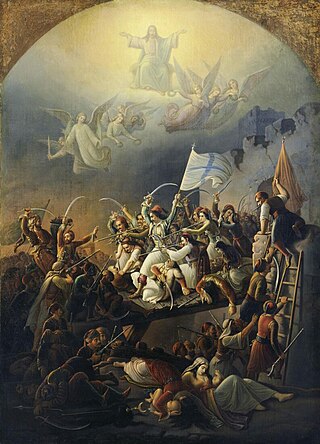
The Third Siege of Missolonghi was fought in the Greek War of Independence, between the Ottoman Empire and the Greek rebels, from 15 April 1825 to 10 April 1826. The Ottomans had already tried and failed to capture the city in 1822 and 1823, but returned in 1825 with a stronger force of infantry and a stronger navy supporting the infantry. The Greeks held out for almost a year before they ran out of food and attempted a mass breakout, which however resulted in a disaster, with the larger part of the Greeks slain. This defeat was a key factor leading to intervention by the Great Powers who, hearing about the atrocities, felt sympathetic to the Greek cause. Their support would prove decisive in helping the Greeks win the war and gain independence.

Dimitrios Kallergis was a fighter of the Greek War of Independence, major general, politician and one of the most important protagonists of the 3 September 1843 Revolution.

Odysseas Androutsos was a Greek armatolos in eastern continental Greece and a prominent figure of the Greek War of Independence.

The Battle of Dervenakia was the Greek victory over the Ottoman forces on 6–8 August 1822, an important event in the Greek War of Independence.

The Destruction of Psara was the killing of thousands of Greeks on the island of Psara by Ottoman troops during the Greek War of Independence in 1824.
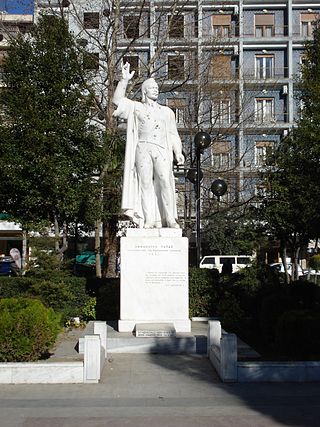
Emmanouel Pappas was a prominent member of Filiki Eteria and leader of the Greek War of Independence in Macedonia.

The Battle of Vasilika was fought between Greek revolutionaries and the Ottoman Empire during the Greek War of Independence.

The Military-Political System of Samos was a provisional regime that existed in the island of Samos during the Greek War of Independence.

The London Protocol of 1830, also known as the Protocol of Independence in Greek historiography, was a treaty signed between France, Russia, and Great Britain on 3 February 1830. It was the first official international diplomatic act that recognized Greece as a fully sovereign and independent state, separate from the Ottoman Empire. The protocol afforded Greece the political, administrative, and commercial rights of an independent state, and defined the northern border of Greece from the mouth of the Achelous or Aspropotamos river to the mouth of the Spercheios river. As a result of the Greek War of Independence, which had broken out in 1821, the autonomy of Greece in one form or another had been recognized already since 1826, and a provisional Greek government under Governor Ioannis Kapodistrias existed, but the conditions of the Greek autonomy, its political status, and the borders of the new Greek state, were being debated between the Great Powers, the Greeks, and the Ottoman government.
Michail Komneinos Afentoulief or Afentoulis was a Greek who lived in Russia and served as an officer in the Imperial Russian Army. He is best known for his participation in the Greek Revolution and his activities on the island of Crete during the period 1822–23.
Kyriakos Skourtis was a captain from Hydra Island, who participated in the Greek Revolution of 1821. He is known mainly for his appointment as commander of the land forces by the government of Georgios Kountouriotis in 1825, although he was a naval officer and completely inexperienced at land.
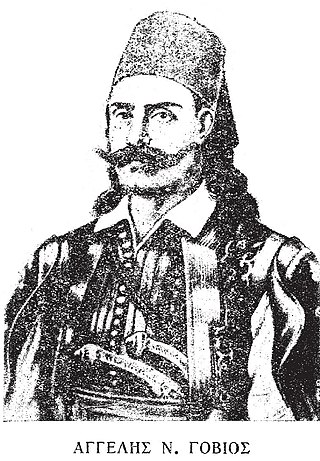
Angelis Govios or Govginas was a leader of the Greek War of Independence. He is known for the reorganization of the Struggle against the Ottomans in Euboea. A statue in his honour has been erected near the Euboean town of Psachna.
Stamatios (Stamos) Kapsas, known as Kapetan Chapsas, was a chieftain of the Greek Revolution of 1821 from Chalkidiki.

The 1789–1793 Souliote War was an armed conflict between Ali Pasha of Ioannina and a coalition of Souliotes and their Muslim allies. The war lasted between February 1789 and April 1793 and was fought in the context of the Russo-Turkish War (1787–1792) and local power struggles. The Souliotes achieved a defensive victory but their actions did not foment a Christian insurrection as the Russians had hoped.
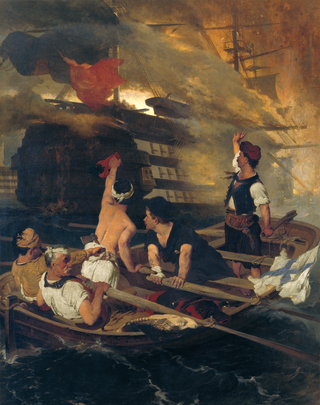
The burning of the Ottoman flagship off Chios took place on the night of 18 June 1822. The event, occurring during the Greek War of Independence, was a reprisal for the Chios massacre which occurred two months earlier. Two thousand Ottoman sailors were killed, as was Nasuhzade Ali Pasha, the Kapudan Pasha of the Ottoman Navy.
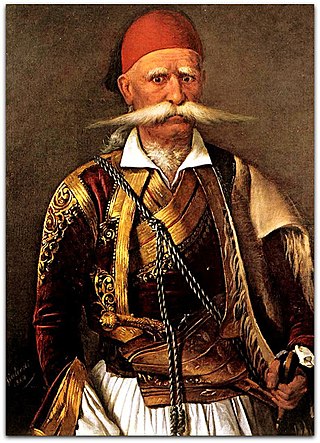
Yiannis Xykis, more commonly known as Dyovouniotis, was a Greek chieftain in Roumeli and a hero of the Greek War of Independence.

Andreas Pipinos was a Greek military officer during the Greek War of Independence.
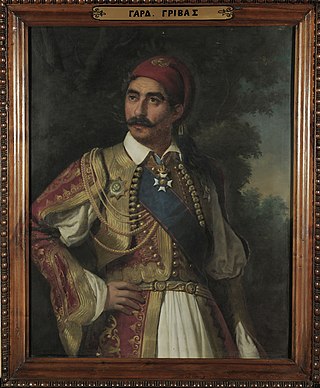
Gardikiotis Grivas, was a Greek leader in the Greek War of Independence in 1821. He distinguished himself in many battles, especially in the Battle of Arachova. He also served as Othon 's aide, undertaking to deal with the movement of 3 September 1843, as well as the rebellion of his brother, Theodoros Grivas.
















